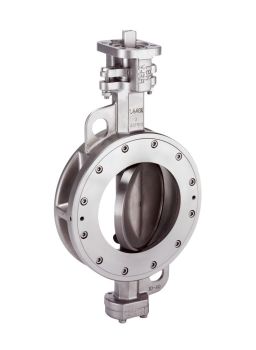Triple eccentric butterfly valves
Our triple eccentric butterfly valves offer a first-class solution for industrial applications that place the highest demands on tightness and resilience. Our high-performance valves with the triple eccentric principle impress with their extreme temperature resistance up to + 400 °C. With standard conformity in accordance with EN 593, the high-performance butterfly valve offers proven safety and quality for your application. The triple-eccentric butterfly valve is available as a lug-type or flanged butterfly valve.
Flexible automation thanks to GEFA Multitop
The GEFA Multitop system in accordance with ISO 5211 enables numerous actuation types without any problems, giving you maximum flexibility when controlling your systems. This ensures easy integration into existing systems and individual adaptability to your process requirements.
Service-friendly thanks to intelligent safety features of the butterfly valve
The triple-eccentric high-performance valves are designed for easy maintenance and maximum operational reliability. The swivel shaft limiter and the visual position indicator on the shaft ensure that the damper remains in the correct position even during servicing and that incorrect positions are avoided. In addition, the robust shaft seal in accordance with the TA-Luft standard ensures long-lasting tightness and significantly reduces maintenance work. These sophisticated features not only make servicing easier, but also make a decisive contribution to the durability and reliability of the butterfly valve in demanding applications.
Innovative lamella seat for reliable tightness
The lamella seat of our triple-eccentric high-performance butterfly valves ensures a leak-free seal in both pressure directions thanks to the stainless steel/graphite lamella seal and remains completely tight at temperatures from - 50 °C to + 400 °C. Thanks to the eccentric design and the fixed offset angle to the sealing surface, the butterfly valve operates friction-free and without a clamping effect. The seat ring is integrated into the body, which prevents one-sided wear and enables a flexible, self-centring seal. This achieves maximum tightness in accordance with DIN EN 12266 part 1, leakage rate A, with minimum switching torque.



